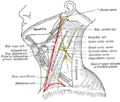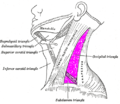Subclavian triangle
Spirometra erinaceieuropaei is a species of tapeworm that is known to infect both animals and humans. This tapeworm is a member of the family Diphyllobothriidae and is the causative agent of a disease known as sparganosis.
Life Cycle[edit]
The life cycle of Spirometra erinaceieuropaei involves several hosts. The primary hosts are typically carnivores such as dogs or cats, while the intermediate hosts can be a variety of animals including frogs, snakes, and rodents. Humans can become infected by consuming undercooked meat from an infected intermediate host, or by drinking water contaminated with the parasite's eggs.
Symptoms and Diagnosis[edit]
In humans, infection with Spirometra erinaceieuropaei can lead to a variety of symptoms, including abdominal pain, nausea, and diarrhea. In some cases, the parasite can migrate to other parts of the body, leading to more serious complications such as seizures or neurological damage.
Diagnosis of Spirometra erinaceieuropaei infection is typically made through the identification of the parasite's eggs in a stool sample. However, this can be challenging as the eggs are often passed intermittently and may not be present in every sample.
Treatment and Prevention[edit]
Treatment for Spirometra erinaceieuropaei infection typically involves the use of antiparasitic medications. In some cases, surgical removal of the parasite may be necessary.
Prevention of Spirometra erinaceieuropaei infection involves avoiding consumption of undercooked meat from potential intermediate hosts, and ensuring that drinking water is free from contamination.
See Also[edit]
Ad. Transform your life with W8MD's Budget GLP-1 injections from $75


W8MD offers a medical weight loss program to lose weight in Philadelphia. Our physician-supervised medical weight loss provides:
- Weight loss injections in NYC (generic and brand names):
- Zepbound / Mounjaro, Wegovy / Ozempic, Saxenda
- Most insurances accepted or discounted self-pay rates. We will obtain insurance prior authorizations if needed.
- Generic GLP1 weight loss injections from $75 for the starting dose.
- Also offer prescription weight loss medications including Phentermine, Qsymia, Diethylpropion, Contrave etc.
NYC weight loss doctor appointmentsNYC weight loss doctor appointments
Start your NYC weight loss journey today at our NYC medical weight loss and Philadelphia medical weight loss clinics.
- Call 718-946-5500 to lose weight in NYC or for medical weight loss in Philadelphia 215-676-2334.
- Tags:NYC medical weight loss, Philadelphia lose weight Zepbound NYC, Budget GLP1 weight loss injections, Wegovy Philadelphia, Wegovy NYC, Philadelphia medical weight loss, Brookly weight loss and Wegovy NYC
|
WikiMD's Wellness Encyclopedia |
| Let Food Be Thy Medicine Medicine Thy Food - Hippocrates |
Medical Disclaimer: WikiMD is not a substitute for professional medical advice. The information on WikiMD is provided as an information resource only, may be incorrect, outdated or misleading, and is not to be used or relied on for any diagnostic or treatment purposes. Please consult your health care provider before making any healthcare decisions or for guidance about a specific medical condition. WikiMD expressly disclaims responsibility, and shall have no liability, for any damages, loss, injury, or liability whatsoever suffered as a result of your reliance on the information contained in this site. By visiting this site you agree to the foregoing terms and conditions, which may from time to time be changed or supplemented by WikiMD. If you do not agree to the foregoing terms and conditions, you should not enter or use this site. See full disclaimer.
Credits:Most images are courtesy of Wikimedia commons, and templates, categories Wikipedia, licensed under CC BY SA or similar.
Translate this page: - East Asian
中文,
日本,
한국어,
South Asian
हिन्दी,
தமிழ்,
తెలుగు,
Urdu,
ಕನ್ನಡ,
Southeast Asian
Indonesian,
Vietnamese,
Thai,
မြန်မာဘာသာ,
বাংলা
European
español,
Deutsch,
français,
Greek,
português do Brasil,
polski,
română,
русский,
Nederlands,
norsk,
svenska,
suomi,
Italian
Middle Eastern & African
عربى,
Turkish,
Persian,
Hebrew,
Afrikaans,
isiZulu,
Kiswahili,
Other
Bulgarian,
Hungarian,
Czech,
Swedish,
മലയാളം,
मराठी,
ਪੰਜਾਬੀ,
ગુજરાતી,
Portuguese,
Ukrainian







